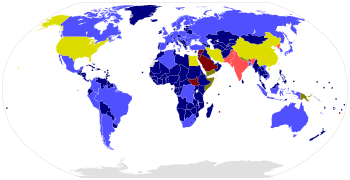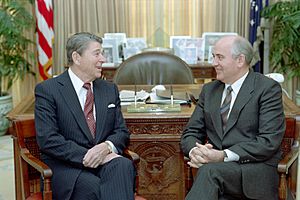Comprehensive Nuclear-Test-Ban Treaty facts for kids

Participation in the Comprehensive Nuclear-Test-Ban Treaty
|
|||
| Signed | 24 September 1996 | ||
|---|---|---|---|
| Location | New York City | ||
| Effective | Not in force | ||
| Condition | 180 days after ratification by
all 44 Annex 2 countries
Algeria, Argentina, Australia, Austria, Bangladesh, Belgium, Brazil, Bulgaria, Canada, Chile, China, Colombia, Egypt, Finland, France, Germany, Hungary, India, Indonesia, Iran, Israel, Italy, Japan, Mexico, Netherlands, North Korea, Norway, Pakistan, Peru, Poland, Romania, Russia, Slovakia, South Africa, South Korea, Spain, Sweden, Switzerland, Turkey, Ukraine, United Kingdom, United States, Vietnam, Zaire
|
||
| Signatories | 187 | ||
| Ratifiers | 178 (states that need to take further action for the treaty to enter into force: China, Egypt, India, Iran, Israel, North Korea, Pakistan, United States) | ||
| Depositary | Secretary-General of the United Nations | ||
| Languages | Arabic, Chinese, English, French, Russian, and Spanish | ||
| http://www.ctbto.org | |||
The Comprehensive Nuclear-Test-Ban Treaty (CTBT) is an important international agreement. It aims to stop all nuclear weapons test explosions. This includes any other nuclear explosions, whether for military or peaceful uses. The treaty covers tests everywhere: underground, underwater, and in the atmosphere. The United Nations General Assembly adopted it on September 10, 1996. However, it has not yet officially started. This is because eight specific countries still need to approve it.
Contents
History of Nuclear Test Bans
The idea of controlling nuclear weapons began in 1945. This was right after the first nuclear tests. Countries like Canada and the United Kingdom called for a meeting. They wanted to discuss how to manage this new powerful technology.
Between 1945 and 1963, many nuclear tests happened. There were 499 tests in total. People became very worried about the effects of these tests. Especially concerning was nuclear fallout. This is radioactive dust that spreads after an explosion. A famous example was the Castle Bravo test in 1954. Its fallout spread far and made many Japanese fishermen sick.
Early Efforts for a Ban
In 1954, after the Castle Bravo test, India's Prime Minister Jawaharlal Nehru asked for a "standstill agreement." This meant stopping all nuclear tests. Soon after, talks began between the US, UK, and the Soviet Union. A big challenge was how to check if countries were following the rules. This is called "verification." Western countries worried the Soviet Union might secretly test weapons. The Soviet Union saw on-site checks as spying.
Because of these disagreements, they decided on a partial ban. This led to the Partial Test Ban Treaty (PTBT) in 1963. This treaty banned nuclear explosions underwater, in the atmosphere, and in outer space. It was a big step forward.
Results of the Partial Ban
The PTBT had mixed results. On one hand, the amount of radioactive particles in the air dropped a lot. This was good for public health. On the other hand, nuclear testing didn't stop completely. Countries continued to test underground. From 1964 to 1996, about 1,377 underground tests took place. Some of these tests still released radioactive gas.
The PTBT helped lead to the Nuclear Non-proliferation Treaty (NPT) in 1968. This treaty aimed to stop the spread of nuclear weapons. Countries without nuclear weapons agreed not to get them. All countries, including those with nuclear weapons, agreed to work towards getting rid of all nuclear weapons. However, some countries like India, Pakistan, and Israel did not sign the NPT. They felt it was unfair because it limited non-nuclear states but not those with weapons.
Steps Towards a Full Ban
In 1974, the Threshold Test Ban Treaty (TTBT) was signed. It banned underground tests above a certain size. In 1976, the Peaceful Nuclear Explosions Treaty (PNET) followed. This treaty covered nuclear explosions for peaceful purposes. Both treaties aimed to limit the power of nuclear explosions. They also included ways to check compliance, like sharing information.
In the late 1970s, the US, UK, and Soviet Union tried again for a full test ban. They made good progress. But disagreements over how to check compliance stopped the talks. In 1985, Soviet leader Mikhail Gorbachev announced a stop to testing. US President Ronald Reagan also supported a full test ban. Talks restarted in 1987.
Negotiations for the CTBT
Not much progress was made until the end of the Cold War in 1991. After that, countries wanted to turn the Partial Test Ban Treaty into a full ban. With strong support from the UN, talks for the Comprehensive Test-Ban Treaty began in 1993.
Adoption of the Treaty
For three years, countries worked hard to write the treaty. However, the group negotiating it couldn't agree on the final text. So, Australia sent the text directly to the United Nations General Assembly in New York City. On September 10, 1996, the CTBT was adopted. A large majority of countries voted for it.
What the Treaty Requires
(Article I):
- Each country that signs the treaty promises not to carry out any nuclear weapon test explosion. They also promise not to do any other nuclear explosion. This applies to any place under their control.
- Each country also promises not to cause, encourage, or help in any way with any nuclear weapon test explosion or any other nuclear explosion.
Status of the Treaty
The CTBT was adopted by the United Nations General Assembly in 1996. It was opened for countries to sign on September 24, 1996. As of September 2023, 178 countries have officially approved the treaty. Another nine countries have signed it but not yet approved it.
For the treaty to officially start, 44 specific countries must approve it. These are called "Annex 2 states." They were part of the CTBT talks and had nuclear power or research reactors at that time. As of 2016, eight of these Annex 2 states have not approved the treaty:
- China, Egypt, Iran, Israel, and the United States have signed but not approved it.
- India, North Korea, and Pakistan have not signed it at all.
Monitoring for Compliance
Special technologies are used to check if countries are following the treaty. This is called monitoring. These technologies look for any signs of a nuclear explosion.
- Seismic monitoring: This uses special sensors to detect ground vibrations. It's like feeling an earthquake. A network of 50 main stations and 120 extra stations around the world do this.
- Hydroacoustics: This listens for sounds in the ocean. It uses underwater microphones called hydrophones. There are 11 stations to detect underwater explosions.
- Infrasound: This detects very low-frequency sounds in the atmosphere. These sounds are too low for humans to hear. Nuclear explosions can create changes in air pressure that infrasound stations pick up.
- Radionuclide monitoring: This looks for tiny radioactive particles or gases. These are released into the air or ground after a nuclear explosion. For example, they look for radioactive xenon gas.
All these methods together form the International Monitoring System (IMS). This system collects data from all over the world.
The CTBTO
The Preparatory Commission for the Comprehensive Test Ban Treaty Organization (CTBTO) was created to build this monitoring system. It is based in Vienna, Austria. The CTBTO collects and analyzes all the data from the IMS. It then shares this information with member countries. If a country suspects another has broken the treaty, they can ask for an on-site inspection. This means experts would go to the suspected location to investigate.
The monitoring network has 337 facilities globally. Over 260 of these are already certified and working.
Recent Nuclear Testing
Since the CTBT was opened for signing in 1996, three countries have tested nuclear weapons:
- India and Pakistan each carried out two sets of tests in 1998.
- North Korea has conducted six announced tests: in 2006, 2009, 2013, two in 2016, and one in 2017.
All of North Korea's tests were detected by the International Monitoring System. For example, the January 2016 test caused an "artificial earthquake" of magnitude 5.1. The September 2017 North Korean test was believed to be a hydrogen bomb. It had an explosive power of about 120 kilotons.
See also
 In Spanish: Tratado de Prohibición Completa de los Ensayos Nucleares para niños
In Spanish: Tratado de Prohibición Completa de los Ensayos Nucleares para niños
- List of weapons of mass destruction treaties
- Comprehensive Nuclear-Test-Ban Treaty Organization
- Comprehensive Nuclear-Test-Ban Treaty Organization Preparatory Commission
- National technical means of verification
- Nuclear disarmament
- Nuclear-free zone
- Treaty on the Prohibition of Nuclear Weapons


